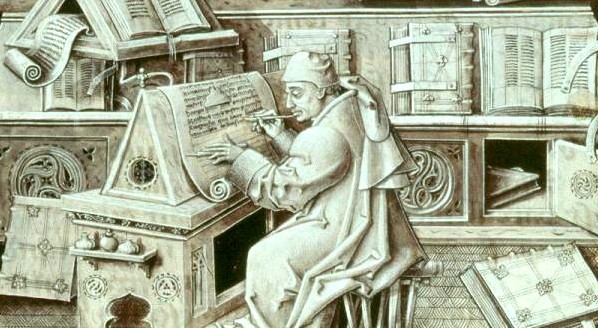The early morning light filtered through the small windows of the scriptorium—the manuscript copying room—where a scribe was hunched over a table on which lay the parchment he was inscribing. His back ached from curling his body day after day over the tilted table, sitting on a backless stool, holding his writing arm out across the parchment, leaning close for lack of light at this time of year in the far north in Ireland.

His hand moved in a slow rhythm from ink pot to parchment where he traced the open end of his quill in the shape of the letters he had practiced for years. This part was mindless. Tedious. Dreary. But he was always mentally alert and focussed for fear of misspelling a word or his eye skipping over a phrase. Making a mistake meant using a small knife to slice away at the errant letter or word.
The previous day he had misspelled one word, and, as usual, he blamed it on the pesky Titivillus, the imaginary demon invented by the scribes who was said to be intent on causing them to make mistakes in their scribal duties. The joke about Titvillus served to have someone to blame for mistakes, and as a reminder that the duty of copying revered documents–especially Holy Scripture–was a mission to be taken seriously. Though slow and tedious, the copying of Scripture was a mission.
The copy of the Bible this monk was working on was finally nearing completion—five years after it began.
The room was cold because no fire was allowed in the scriptorium. The risk to the fragile and flammable parchments was too great. Theft of a manuscript was a crime. One monk wrote a warning on the first page: “If anyone steal this book, let him die the death; let him be fried in the pan; let the falling sickness and fever seize him; let him be broken on the wheel and hanged. Amen.” He did not want to lose his work.
Vikings raided monasteries whenever they could, ruthlessly stealing, destroying, and killing. To protect the precious manuscripts the scriptorium was located in a fortified tower. Each morning the scribes had to climb a ladder twenty feet and pull the ladder up after them into the isolated and protected room.
But for all the tedium and pain, fear and tension, the scribes did experience the truth of the texts they were copying. Every day they read some of the Psalms—slowly, prayerfully, out loud. Over the course of months and years all the words and all of the images formed the imagination of these men. Their whole way of thinking of reality was through the prism of Scripture. And while later generations would not know these people, they would benefit from this fact: the mission that these scribes in northern Europe took on during the Dark Ages when literacy was practically extinct was the way the text of Scripture was carried through the centuries.
How seriously do we take Scripture today?
Yes.
Marvelous details — I was amused by the irony of the article’s having misspelled the name of the error-demon (the article gives it, more than once, as “Titvillus”: correctly, it’s Titivillus). You may also wish to correct “coping” to “copying”: Titivillus is plainly not giving you a moment’s peace.